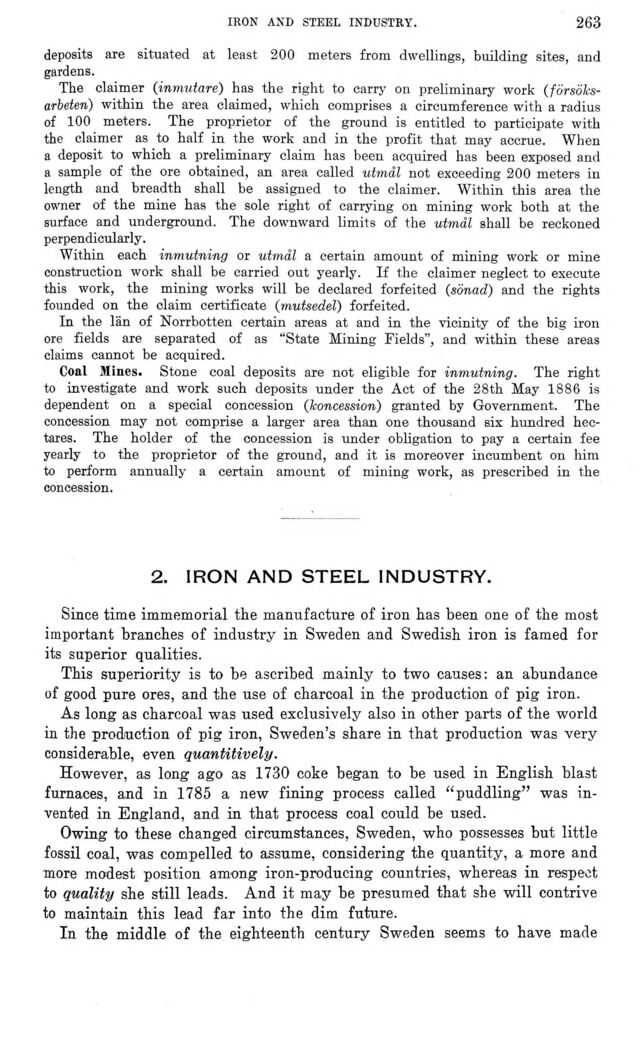
Full resolution (JPEG) - On this page / på denna sida - VI. Mining and Metallurgical Industry. General Survey. By C. Sahlin - 1. Mining. By Valfrid Petersson - 2. Iron and Steel Industry. By J. A. Leffler

<< prev. page << föreg. sida << >> nästa sida >> next page >>
Below is the raw OCR text
from the above scanned image.
Do you see an error? Proofread the page now!
Här nedan syns maskintolkade texten från faksimilbilden ovan.
Ser du något fel? Korrekturläs sidan nu!
This page has never been proofread. / Denna sida har aldrig korrekturlästs.
iron and steel industry.
263
deposits are situated at least 200 meters from dwellings, building sites, and
gardens.
The claimer (inmutare) has the right to carry on preliminary work
(försöksarbeten) within the area claimed, which comprises a circumference with a radius
of 100 meters. The proprietor of the ground is entitled to participate with
the claimer as to half in the work and in the profit that may accrue. When
a deposit to which a preliminary claim has been acquired has been exposed and
a sample of the ore obtained, an area called utmål not exceeding 200 meters in
length and breadth shall be assigned to the claimer. Within this area the
owner of the mine has the sole right of carrying on mining work both at the
surface and underground. The downward limits of the utmdl shall be reckoned
perpendicularly.
Within each inmutning or utmdl a certain amount of mining work or mine
construction work shall be carried out yearly. If the claimer neglect to execute
this work, the mining works will be declared forfeited (sönad) and the rights
founded on the claim certificate (mutsedel) forfeited.
In the län of Norrbotten certain areas at and in the vicinity of the big iron
ore fields are separated of as "State Mining Fields", and within these areas
claims cannot be acquired.
Coal Mines. Stone coal deposits are not eligible for inmutning. The right
to investigate and work such deposits under the Act of the 28th May 1886 is
dependent on a special concession (koncession) granted by Government. The
concession may not comprise a larger area than one thousand six hundred
hectares. The holder of the concession is under obligation to pay a certain fee
yearly to the proprietor of the ground, and it is moreover incumbent on him
to perform annually a certain amount of mining work, as prescribed in the
concession.
2. IRON AND STEEL INDUSTRY.
Since time immemorial the manufacture of iron has been one of the most
important branches of industry in Sweden and Swedish iron is famed for
its superior qualities.
This superiority is to be ascribed mainly to two causes: an abundance
of good pure ores, and the use of charcoal in the production of pig iron.
As long as charcoal was used exclusively also in other parts of the world
in the production of pig iron, Sweden’s share in that production was very
considerable, even quantitively.
However, as long ago as 1730 coke began to be used in English blast
furnaces, and in 1785 a new fining process called "puddling" was
invented in England, and in that process coal could be used.
Owing to these changed circumstances, Sweden, who possesses but little
fossil coal, was compelled to assume, considering the quantity, a more and
more modest position among iron-producing countries, whereas in respect
to quality she still leads. And it may be presumed that she will contrive
to maintain this lead far into the dim future.
In the middle of the eighteenth century Sweden seems to have made
<< prev. page << föreg. sida << >> nästa sida >> next page >>